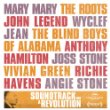In 2004, I reported on a history trip made by about 25 Indiana University-South Bend students and professors who toured civil rights sites in four southern states. The history professors have taken a group of students on this trip – which is known as Freedom Summer - every other year since 2000. The students had a chance to visit the Civil Rights museums in Memphis and Nashville. They walked across the Edmund Pettus Bridge in Selma, Ala., and toured the houses where the Rev. Martin Luther King lived in Montgomery and the house where Medgar Evers was shot in Jackson. The students also met some of the people who organized, marched and sang freedom songs during the movement. During the trip, we met one of those freedom singers when our group reached Albany, Ga.
Music – and especially gospel music – played a major role in what was largely a church based movement.The country at large didn’t understand how spirituals, gospel music and protest songs served as the movement’s soundtrack until King and the SCLC came to Albany in 1962. That’s where a group of talented singers was introduced to the nation, in part, because they embarked on a singing tour in the North to raise money for the movement.
During the visit, Rutha Harris, one of the original Freedom Singers, led the students in the singing of several freedom songs. I recall Harris entering the building from the rear and the room being filled with her powerful voice bellowing out a haunting version of “Wade in the Water.” That memory came rushing back to me when I heard Angie Stone’s modern soul version on the new CD Soundtrack for a Revolution. The record features soul, southern soul, gospel folk and hip-hop artists performing freedom songs highlighted in the documentary film of the same name. That film details the key role that freedom songs played in the movement through the use of archival footage and performance by contemporary artists such as Stone, John Legend, Mary Mary, Richie Havens and Anthony Hamilton. These artists perform tunes such as “We Shall Not Be Moved,” “Turn Me Around” and the aforementioned “Wade in the Water.”
Rutha Harris’s rendition of “Wade in the Water” captured the one quality that Soundtrack for a Revolution – a well arranged studio album -- could not: the ability of the unaccompanied human voice to convey emotions such as hope and fear. Still, Soundtrack for a Revolution has many virtues. The performers recruited to participate in this project serve as the primary virtue. Anthony Hamilton and the Blind Boys of Alabama join forces on a rendition of “This May Be the Last Time.” The combination of this legendary gospel quartet with the Hamilton – a singer with a delivery that is steeped in the blues and gospel – is a perfect match.
Of course, many freedom songs started out as church congregational songs that movement singers repurposed as they marched and went to jail. It certainly helps to select vocalists who understand the history of the movement as well as music history. That makes the selection of performers such as Mary Mary and John Legend no-brainers. Mary Mary bring their tight harmonies to the “We Shall Not Be Moved.” Legend adds his raspy voice to “Woke Up This Morning,” a song that epitomizes a movement leader’s understanding of the symbiotic relationship between the sacred and the political. Congregations still sing “woke up this morning with my mind, stayed on Jesus” during testimony and praise services. The civil rights protestors changed the lyrics, substituting Jesus for freedom. The brilliance of the freedom songs and the people who sang them is that they understood that the words Jesus and freedom not mutually exclusive. Many of these young freedom fighters grew up reading 2 Corinthians 3:17 - “where the spirit of the Lord is there is freedom” - in Sunday School.
Soundtrack for a Revolution can be viewed as a work of art, a piece of history and an educational document. Listeners can enjoy the album as art even if they don’t know a lot about the movement for which these songs provided the soundtrack.* However, knowing something about that history allows the listener to make these songs three-dimensional. Soundtrack for a Revolution serves both as an album that stands on its own as a fine album and also and as a piece that can create a larger conversation and a thirst for more knowledge about a pivotal time in our country's history. For those reasons and more, it is Recommended.
By Howard Dukes
* Take the track “This May Be the Last Time.” The inter-racial group who participated the 1961 Freedom Rides to desegregate bus terminals in the Deep South gathered on the East coast before riding the buses South. The day before the Freedom Rides started, the first group of riders ate dinner together. Knowing that they were risking their lives, they called that meal “The Last Supper.” These kinds of details can be found in books such as Parting The Waters: America in the King Years, the first of Taylor Branch’s magisterial three part series on the civil rights movement. I also recommend Juan Williams' Eyes On the Prize, as well as the PBS documentary that the book inspired; Diane McWhorter’s Carry Me Home: Birmingham 1963, David Halberstam’s The Children, and Bruce Watson’s Freedom Summer.

